MythBusters Interview: Adam and Jamie Build a Duct Tape Bridge


Where did you get the idea to build a duct tape bridge?
ADAM SAVAGE: The idea for the duct tape bridge came almost immediately after we were finished sailing the boat around the bay [last season]. We were thinking, what's next, what else could we do? And we had two or three ideas; the bridge was the one we chose for the next bust. We even have a better idea for the next duct tape special.
JAMIE HYNEMAN: We could just keep going on the duct tape thing. It'll never run out.
So is the stuff you used just a regular, standard-issue duct tape?
ADAM SAVAGE: It is. Nashua makes about ten different kinds and it's a middle grade that we keep on settling on as our favorite.
JAMIE HYNEMAN: And there is heavier stuff. I think probably in any of the experiments that we've done, we could've put heavier stuff to use to our benefit, but we're trying to show something that's not unusual. It's a standard heavy-duty duct tape.
How much of what you learned about duct tape strength and capabilities for building the boat were you able to use again for the bridge?
JAMIE HYNEMAN: I think we've learned a lot about how to handle it. The trick with that boat was putting the first layer with the adhesive side out and then the second layer with the adhesive layer in and precisely lining it up. With the bridge it was similar. We knew that over that length duct tape is kinda hard to control so we didn't even try. Adam built this rig to pull out ten strands at a time and we didn't make em really messy but we did sort of let them go where they were gonna go and kind of bundled them up because the strength in this case was about the same.
Interesting. I was going to ask about thatbecause when you guys were building the boat, there was a definite order to the way you laid out the tape. And in this case you just sort of clumped it together.
JAMIE HYNEMAN: Yeah, this was all about tensile strength. And so given the amount of tape that we had to usewhat was it?
ADAM SAVAGE: Two hundred rolls of duct tape.
JAMIE HYNEMAN: Yeah, 200 rolls of duct tape over 108 feet. Why fight it, you know? Let it do what it wants to do.
ADAM SAVAGE: It's indicative of how we work with a lot of the materials we end up working with on the show is that you can either go pretty or you can go crunchy. Both have their utilities and both have their advantages and disadvantages. And for the bridge, going crunchy and turning this stuff into basically glorified rope and stringing it together turned out to be really quite effective.
How long is a single roll of duct tape?
ADAM SAVAGE: About 60 yards, 180 feet.
I was going to ask if you guys were worried at all about the structural weaknesses of attaching one roll to another, but I guess you didn't really have to think about that if the distance you had to span was 108 feet.
ADAM SAVAGE: Actually, one of the plans that I wanted to try and do was to find a span that was like 190 feet long so it would be clear we couldn't use a single piece of duct tape for the span of the bridge. But we ran into location limitations there and realized the difference was one that was more interesting to us intellectually than necessary for the narrative of the show.
When you finally figured out that you were going to do a bridge, how did you come up with a plan of attack in terms of what design to go with?
ADAM SAVAGE: We actually had two totally different viewpoints about how it would go. In the beginning, Jamie and I often talk in the abstract, arguing back and forth for different approaches. Often we don't conclude something out of those conversations but we conclude a method of proceeding. So we bandied back and forth for about a day and then we just went down to the shop and started mucking around with duct tape until something became clear.
JAMIE HYNEMAN: I recall specifically going through the exercise of thinking that what duct tape has is tensile strength and it doesn't have any compressive strength or anylike if you were doing a keystone kind of a structure, for example, it wouldn't work. It's all effectively just rope. Going on that premise leaves you with a suspension bridge. There's not a whole lot of other choices involved. So that was the direction that we went.
Why did you opt to not do the weaving thing? You did that a little bit when you were first testing.
ADAM SAVAGE: It didn't seem necessary for the overall construction of the bridge. Again, it's balancing all the elements of time and effectiveness. And while it worked somewhat well in the shop's limited space, I don't think it would have added any necessary structure to the bridge.
JAMIE HYNEMAN: Yeah. It was all about that simple thing again, the tensile strength of it.
ADAM SAVAGE: It was an attempt to add some compressive strength to the floor we were going to walk on, you know?
JAMIE HYNEMAN: What we did, as you can see in the design, is went with a walkway that was only as wide as it had to be to accommodate our feet. You know, like even barely wide enough to even put our feet sideways on it. So it was kind of like a flat rope. And with it done that way, we didn't really have to worry about whether it drooped or became like a bag as we walked across it.
Was there any behind-the-scenes deliberation that viewers didn't get to see?
JAMIE HYNEMAN: We did tests that showed that just three strips of tape were capable of supporting one of us. We used 200 rolls, and most of those rolls were in the walkway. We could've done it with much less. The tighter that you pull a bridge like that, the straighter the line would be that's going across the chasm and it becomes a significantly larger load on the tape the more that you pull on it. You know, like the tauter it is. It's a question of leverage on the middle of the bridge.
And so while we did our experiment here across 30 feet with three strips of tape and that was sufficient, expecting three strips of tape to hold us going across a bridge that's 100 feet would be unrealistic because the leverage is so much greater on it. But dialing in on exactly how much it would hold as a part of that was hard for us. We have a couple of engineers here on staff, and it's a more complex thing than it might seem to be able to estimate exactly how many strips of tape would be required to support a person across that span.
It changes as you put load on it, the leverage. It's not a static thing. The less straight the thing becomes, the more the tensile strength changes. So it was sort of a dynamic thing that we didn'tfrankly, in our sort of seat-of-the-pants engineering approach, we couldn't find a straightforward way of really dialing in on that so we just overdid it a bit. Since we had all these cases of tape, we figured, why not?
How long do you think it would've taken you to build it by hand? Obviously that rig helped speed up the process a lot.
ADAM SAVAGE: I'd say that probably saved us a couple of days in the overall build, maybe a day.
JAMIE HYNEMAN: Yeah, at least a day. I don't think the thought actually ever crossed our minds that we would do it any other way. We might have strung them out by putting them all on a single axle instead of having the ten axles suspended above each other, which was Adam's idea ... and it turned out to be quite effective. I had my hesitations about it because all those little rollers and everything are a little difficult to set up, but Adam cranked through it and it was clearly the best way to do it.
You had to make some last-minute modifications to the bridge too, once you got it on-site.
ADAM SAVAGE: You know, in all of this there's a lot of moving parts. There's the span itself, but then what order do you make the span in and attach it to where it's going to go? The normal way you might make a rope bridge is to just start stringing rope across the span and then bind it together. We didn't have that luxury, we wanted to build the thing in its entirety. And this is kind of another indicative way that we solve problems. Knowing that this was a tricky thing, we went out on-site, we took careful pictures and measurements of the stuff we were going to mount it to on-site and then the whole time we were working on the bridge and doing ideation on it, we were talking about ways of attaching. And we went through probably about a dozen different ideas before coming across what was really the simplest possible way to do it. The ideas were more like different orders of doing things. A lot of times the order that you do things in is absolutely critical.
JAMIE HYNEMAN: We could've built the thing entirely out on-site but it would have been much slower because having to suspend ourselves with some other kind of means while we're constructing it would've been very tedious, it would have taken many times longer, in fact. And so we opted to do it on the ground and then pull it into place.
Will Jamie and Adam make it across their duct tape bridge? Watch the episode tonight to find out, and check PopularMechanics.com tomorrow morning to hear what the guys learned from their experimentand what's the most terrifying thing they've done on MythBusters so far.

.css-cuqpxl:before{padding-right:0.3125rem;content:'//';display:inline;} Mythbusters .css-xtujxj:before{padding-left:0.3125rem;content:'//';display:inline;}

The MythBusters' Rocket Knife Slices at 165 Mph

Check Out New 'Mythbusters' Crew in First Trailer

Watch Adam Savage Build This Incredible 'Shining' Maze
How It Works: The MythBusters' Mechanical Sharkzilla
Jamie & Adam Preview Upcoming MythBusters Season
Adam Savage on the Mythbusters' New Show, Unchained Reaction
Mythbuster Adam Savage on the Evils of Censorship
MythBusters Misfire Sends Cannonball Into Neighborhood Home
MythBuster Kari Byron Visits PopMech's Offices Video
Car Myths, Debunked!
Turning a Porsche Around: Mod Pictures
- Cast & crew
Duct Tape: The Return
- Episode aired Mar 6, 2016

In the MythBusters final season farewell, they build a trebuchet and attempt to save Buster's life with their favorite mechanical cure all: Duct Tape. In the MythBusters final season farewell, they build a trebuchet and attempt to save Buster's life with their favorite mechanical cure all: Duct Tape. In the MythBusters final season farewell, they build a trebuchet and attempt to save Buster's life with their favorite mechanical cure all: Duct Tape.
- Chris Williams
- Jamie Hyneman
- Adam Savage

- Self - Host

- Self - Narrator
- All cast & crew
- Production, box office & more at IMDbPro
Did you know
- Trivia The MythBusters have used almost 5,000 rolls of duct tape. That's more than 83 miles of the sticky stuff!
User reviews
- March 6, 2016 (United States)
- See more company credits at IMDbPro
Technical specs
- Runtime 42 minutes
Related news
Contribute to this page.
- IMDb Answers: Help fill gaps in our data
- Learn more about contributing
More to explore

Recently viewed
MythBusters (2003–…): Season 10, Episode 1 - Duct Tape Island - full transcript
Can Adam and Jamie survive on a deserted island using just duct tape?
Duct Tape Island (Episode)
- Edit source
- View history
Duct Tape Island is the first episode of the 2012 Season (Season 12, episode 1 ). Adam Savage and Jamie Hyneman are the only two hosts of this episode; Grant Imahara , Tori Belleci and Kari Byron don't appear in this episode.The goals of the episode were to see if duct tape can allow you to survive on a desert island. [1]
- 1 Episode Cast:
- 2.1 Duct Tape Island Survival:
- 3 References:
Episode Cast: [ ]
- Adam Savage - Host
- Jamie Hyneman - Host
- Robert Lee - Narrator/Voice
- Robin Banks - Narrator/Voice (Europe)
The Myths: [ ]
Duct tape island survival: [ ].
Marooned on a tropical island (Oahu, Hawaii) with only a pallet of duct tape, Adam and Jamie had to use it to perform the tasks needed for survival. Their goals were to get home and...
[2]
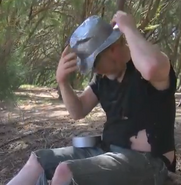
References: [ ]
- ↑ IMDb Ref: tt2307725
- ↑ Wikipedia
- 1 Cannonball accident
- 2 Kari Byron
- 3 Frank Doyle

MythBusters
Video share options, share this on, send this by.
MythBusters use their explosive mixture of science, engineering, ingenuity and luck to not only retell the myths but also put them to the test for your entertainment.
Mondays 8.30pm on ABC TV Plus and ABC iview.
- Jamie Hyneman, Adam Savage

Duct Tape Kayak

Introduction: Duct Tape Kayak

After watching the Mythbusters episode on Duct Tape Myths, I decided to take a whack at creating my own duct tape boat. Rather than the two-man sailboat that Jamie and Adam designed, I went for a much slimmer one-man kayak. Only $20 of supplies and a day or two of work; this Kayak makes for a great weekend summer project!
Step 1: Materials

All that you need in the way of materials are some duct tape rolls, a little bit of wood glue, and wood for the frame. For the sake of simplicity and cheapness, I bought a good number of 3/16"x1-3/8"x8' cedar strips to make my frame. At about 90 cents apiece, they were the perfect option. My materials list came out to this: Three 55 yard rols of duct tape 8 cedar strips 1 bottle of gorilla wood glue Altogether less than 20$.
Step 2: Design

As shown in the picture, the basic design consists of two full-length curved sides, a "hull" piece that follows along the bottom edge of the boat, and reinforcing "ribs" that provide the majority of the strength in the frame. Once the frame is made, the "skin" of the boat -which consists of two layers of duct tape- stretches across the frame.
Step 3: Frame

There are 5 steps in the creation of the frame: Step 1: Using 2 angled brace strips, bend the edge pieces and clamp them into place. Glue the seams between the braces and the edge pieces. (see Pictures 1 and 2) Step 2: The "hull" piece consists of two angled pieces held between two straight strips. Once glued and attached, this piece constitutes the bottom edge of the kayak. (see Pictures 3, 4, and 5) Step 3: As shown in Picture 6, cut out the vertical brace pieces that connect the horizontal braces in Step 1 to the "hull" piece in Step 2. Attach them as shown. (see Pictures 6, 7, and 8) Step 4: Cut out and attach the "ribs" to the bottom edge of the boat and the curved side strips of the frame. My particular design included 6 of these "ribs" on each side. (see Pictures 9 and 10) Step 5: Cut one of the full length strips into two thinner pieces; attach these at the front and back of the kayak and secure them about halfway along each of the "ribs". (see Picture 11) Now you're finished with the frame!
Step 4: Duct Tape!

In order to make the entire "skin" out of duct tape, a minimum of 2 layers are needed. The first layer (as shown in Picture 1) is applied sticky-side-up, with each strip of duct tape overlapping halfway onto the last. Be careful when you are doing corners and angled edges and take your time so that you dont get ugly ripples. Once the first layer is applied, cover it with a second layer of tape (see Picture 4). This time, apply it sticky-side-down. Additional layers can be added to increase strength and waterproof-ness, but at this point you're finished with the "skin" of the kayak.
Step 5: You're Finished!

At this point, you're basically done! I would recommend taking time to smooth down all the duct tape seams to make sure they are tight and smooth. The last thing you want is water seeping its way into your Duct Tape Kayak! Good Luck and enjoy skimming through the water in your sleek Duct Tape Kayak!

Finalist in the The Great Outdoors Duct Tape Contest
Recommendations

Made with AI - Autodesk Design & Make - Student Contest

Big and Small Contest

Engineering in the Kitchen - Autodesk Design & Make - Student Contest

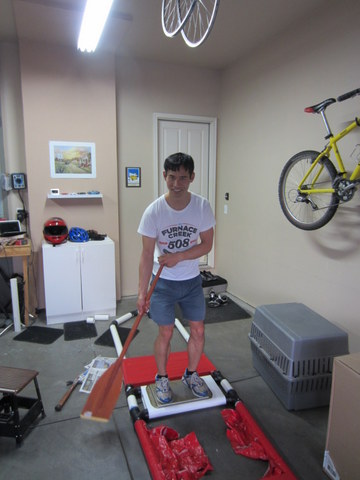
The Duct Tape Paddleboard Project
We had just watched two episodes of Mythbusters—one about creating a sailboat out of duct tape and another about surviving on a deserted island with only pallets of the famed sticky, shiny, silver stuff—so you can forgive Kelly and I for talking about how we should create a duct tape sailboat together. But then, in my sometimes rational mind, I decided perhaps this wasn’t such an Einsteinian idea. Surely, instead, I should start out with something less ambitious. Something quicker to build and wouldn’t require welding equipment, as the Mythbuster’s rebar-framed sailboat did. Something that would still float, but was a tad smaller.
“Let me try making a duct tape stand-up paddleboard first,” I resolved. “It’ll be for proof of concept and give me practice with working with duct tape.”
It seemed all so simple in my head: just create a frame out of PVC pipe and wrap duct tape around it. Make sure it is sealed well enough to preserve its buoyancy and voila! A paddleboard that costs a fraction of what a “real” one would go for brand new.
A back-of-the-envelope calculation even proved to myself that it would be able to support my weight. My design parameters were a 29″ width, 11′ length and 2″ (inside-diameter) pipe—which effectively gave a 2.5″ height. “It should be able to float with up to 240 lbs. on it,” I concluded.
So in early May I made a Home Depot run for the PVC pipe, fittings, and duct tape:

In mid-June I created a frame. With a compound miter saw this turned out to be quite easy:
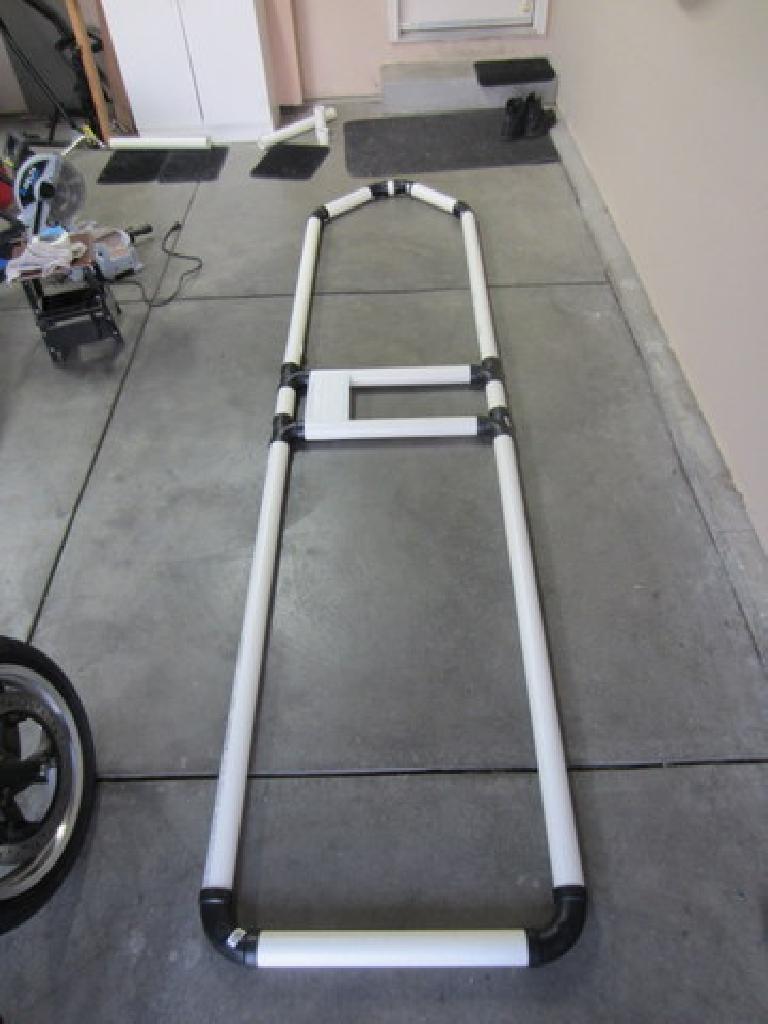
So then it was just a matter of wrapping duct tape around it… which turned out to be extremely tedious. And after the first few hours of doing so, there was the first failure: the frame came apart at a joint. The PVC cement, it turned out, was not strong enough especially when considering that I was wrapping the tape with quite a bit of tension.
Unfortunately, when this happened, the tape collapsed onto itself, leaving a sticky, inseparable mess. There was no choice but the cut the layers of tape and try again.

My neighbor Tim then came over to help and we reinforced the joints with self-tapping screws. “These joints will never come apart now.” we predicted.
Hours later, our prognostication turned out to be wrong. Another joint failed, essentially ending the project. I had already wasted close to 10 hours on this, and it was not worth it to spend another 10.
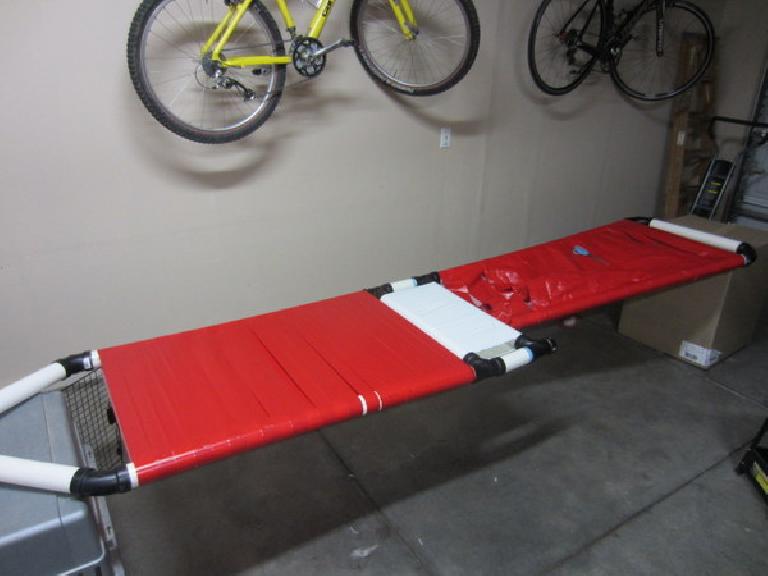
“Maybe I’ll look for some other sort of water flotation device on Craigslist instead,” I concluded. Preferably one that was not made out of duct tape.
One comment:
I am thinking of another approach. use 1/2 plywood for deck and three or four layers of. celetex blue foam...cut out the plywood and foam and shape like you would a surf board. make a port for your skag in aft section of foam..then wrap with duct tape. apply grip tape on top where you stand ↩ Reply
Leave a comment Cancel reply

MythBusters Episode 204: Duct Tape Canyon
Premier Date: June 19, 2013
This episode is a spiritual successor to Duct Tape Island . Adam and Jamie were stranded near Desolation Canyon, Utah with only duct tape, bubble wrap and a few survival essentials (i.e. food, water, and a knife). They had to cross the canyon and reach civilization using these limited resources. Along the way they found out if…
Bubble wrap can be used to make warm clothing.
The temperature at the desert wasteland was around 32 °F (0 °C). To survive, Adam and Jamie crafted ponchos and gloves from bubble wrap held together with duct tape. The bubble wrap was effective at insulating them from the cold.
It is possible to start a fire with a car battery.
Adam shorted out the car battery to create sparks and eventually ignite tinder. When the wire leads became too hot to hold, Adam wrapped them with duct tape for additional insulation.
Duct tape and bubble wrap can be used to make shelter.
Jamie made a low-hanging tent from duct tape and a mattress from bubble wrap, while Adam slept in the broken-down car with a bubble wrap blanket.
Duct tape can be used to improvise a device to help transport heavy supplies.
To pack up their supplies before their hike, Jame built a travois (a type of pull-behind sled) using sticks and tuck tape while Adam made a messenger bag out of duct tape.
A rope made from duct tape can be used to safely rappel into a canyon.
Adam made strands of rope by twisting together four pieces of duct tape, then he combined three such ropes into one stronger rope. Jamie made simple harnesses from duct tape and the pair used this equipment to descend 150 feet (46 m) into the cannon (while also wearing real climbing equipment as a backup).
Duct tape and bubble wrap can be used to make boats for floating down a river with rapids.
In a preliminary experiment, Adam was wrapped in a thick suit of bubble wrap and duct tape to see how he would fair in the river. He found that cold water quickly seeped in and he had difficulty maneuvering, making this method of getting down the river infeasible.
Next, Adam and Jamie built two separate crafts. The basic building blocks for each were sheets of bubble wrap tightly rolled into pontoons. Jamie made a large raft resembling a sofa and Adam made a long kayak. They each paddled their boats downstream and through a series of rapids, only struggling when they reached Class 5 whitewater.
After bypassing a waterfall on land, the MythBusters soon paddled out of the canyon and headed for civilization.
Previous: Episode 203: Crash Cushion, Hypermiling
Next: Episode 205: Painting With Explosives, Bifurcated Boat

Mythbusters
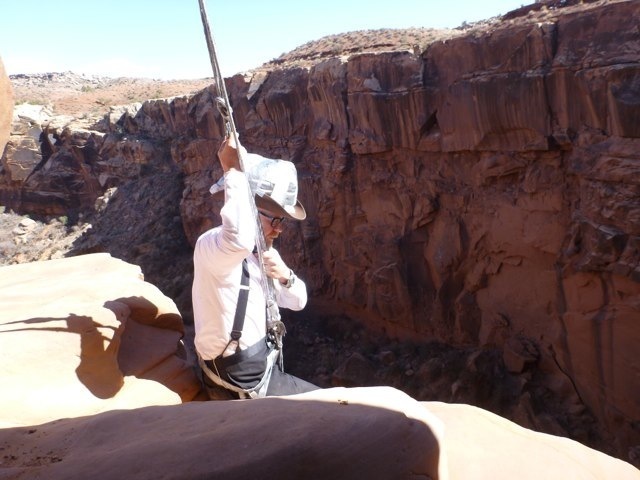
This Discovery Channel favorite had two of my favorite things: big cliffs and whitewater! The cliff was 180’ tall and is in a place we use somewhat frequently when we need a close by big cliff.
We were initially tasked with trying to devise a way to rappel down this cliff with a duct tape rope. The rope would be multiple strands of duct tape that has been stretched and twisted using power drills. These were multi-ply ropes with strands pinched and twisted together to make an even more rigid and stronger half inch thick cord.
We came up with some canyoneering-specific techniques that might work on the duct tape rope (DTR). We wrapped regular static ropes in a precise fashion (a Valdo-tain variation) that would disperse the friction over a wide area of the cord and minimize the heat and melting of the duct tape that otherwise would have been an issue with the use of metal carabiners and standard rappel devices. When they arrived however and we began to discuss this technique the plug was pulled and the decision was made to “cheat it”.
So we created the rappel by using a grey dynamic rope as the rappel cord that resembled duct tape all while having them essentially downclimb the DTR. Safety first when it comes to high demand TV personalities!
The river portion ended up being a bit ridiculous since the river was quite low, therefore the danger was in over-engineering a raft that would minimize the effect that waves would have on the boat. With a HUGE truckload of bubble wrap (of all types) and virtually an unlimited supply of duct tape the hosts easily created boats that managed to keep them dry despite a few decent sized waves.
After leaving Utah they went back to Cali and ran a stretch of the American river with a distinctly different look, size , color, and gradient. I guess they hoped you wouldn’t be watching closely. That river caused the boats a little more trouble, as anticipated.
Recent Posts
- Moab Adventure Tour Guide – Michelle Leber
- Moab Adventure Tour Guide – David Katzenmeyer
- Moab Adventure Tour Guide – Jeremiah Hardy
- Park Fellows – Compare and Book Cheap Airport Parking While Traveling to Moab!
- Moab Adventure Tour Guide – Aidan Multhauf
About Moab Cliffs & Canyons
- Our Tour Guides
- Our Tour Philosophy
- Film & Photo Shoots
- Adventure Tour FAQs
- Customer Reviews
Key Resources
- Canyoneering Guided Tours
- Rock Climbing Guided Tours
- Tower Rock Climbing Tours
- Desert Hiking Guided Tours
- Rockaneering Guided Tours
- Canyoneering Courses
See Reviews On TripAdvisor

COMMENTS
To escape a deserted island, Adam and Jamie build a boat completely out of duct tape and branches.Stream Full Episodes of MythBusters:https://www.sciencechan...
A 2 person sized Sail Boat Made Totally out of Duct Tape and a Wire frame, Discovery HD, Myth Busters.
MythBusters Returns Wednesdays @ 9pm E/P with All-new Episodes!Check out the top 10 strangest myths tested by the MythBusters team: http://dsc.discovery.com/...
Duct Tape Hour: Directed by Alice Dallow. With Jamie Hyneman, Adam Savage, Tory Belleci, Kari Byron. The Mythbusters try everything they can think of with duct tape; lift Jamie and lift a car, fix a boat and build a boat. Then to squeeze in everyone's favorite, explosions, they build a cannon.
The MythBusters patched a damaged boat with duct tape and then floated it in San Francisco Bay. The tape managed to keep the boat afloat, with only minor signs of damage after forty minutes of use. Adam then decided to test whether duct tape can seal an existing leak while the boat is still in the water. Adam noted that it was more difficult to ...
In last season's duct tape special, MythBusters Jamie Hyneman and Adam Savage constructed a boat out of duct tape—and it didn't sink. In tonight's episode, airing at 9 pm on the Discovery ...
The MythBusters built an entire sailboat using 690 square feet (64 m 2) of duct tape for the hull and sail. They then took the boat, dubbed the Stuck on You , into San Francisco Bay. The duct tape boat turned out to be fully functional with no sign of failure and, as stated by Adam, "adequately seaworthy", confirming the myth.
Duct Tape: The Return: With Jamie Hyneman, Adam Savage, Robert Lee. In the MythBusters final season farewell, they build a trebuchet and attempt to save Buster's life with their favorite mechanical cure all: Duct Tape.
MythBusters is a science entertainment TV program created and produced by Australia's Beyond Television Productions for the Discovery Channel. ... Can you create a working sail-boat out of duct tape? Can duct tape be used to construct a potato cannon instead of glue? Is it possible to build a working cannon using duct tape? 127: 14
Our little duct tape boat did great. Held up through the breakers, Here we go. held up in the open water and it held up in the sun. And it did that despite only weighing about 100 pounds. - I'm out. - I'm out. which for a boat that size is incredibly light weight. I've got to say, I'm pretty impressed with the duct tape right now. Excellent.
Duct Tape Island. Adam and Jamie get abandoned on a deserted island with nothing but duct tape between them and life or death! The guys go MythBusters and duct tape vs. wild as they use the mythical material to find food and water, build a camp, and try to get rescued. ← Previous Episode. Next Episode →.
Duct Tape Island is the first episode of the 2012 Season (Season 12, episode 1 ). Adam Savage and Jamie Hyneman are the only two hosts of this episode; Grant Imahara, Tori Belleci and Kari Byron don't appear in this episode.The goals of the episode were to see if duct tape can allow you to survive on a desert island. Adam Savage - Host Jamie Hyneman - Host Robert Lee - Narrator/Voice Robin ...
#MythBusters #FactOrFiction The many mysteries of Duct Tape, can you use it to keep your boat afloat or stop it from sinking more so than it has.Using scienc...
Adam and Jamie take on Indiana Jones to find out if you can flip a motorcycle by jamming a flagpole into its spinning wheel. While Kari, Tory and Grant try to break out of prison using only bed sheets, toilet paper and hair! Adult Themes. This episode was published 3 months ago.
After watching the Mythbusters episode on Duct Tape Myths, I decided to take a whack at creating my own duct tape boat. Rather than the two-man sailboat that Jamie and Adam designed, I went for a much slimmer one-man kayak. Only $20 of supplies and a day or two of work; this Kayak makes for a great weekend summer project!
Mailbag Special. The MythBusters do a fan correspondence catch-up as the team answers your questions and takes mini myth requests - testing if you can eat a spoonful of cinnamon without drinking water and revealing how the camera crew captures explosions. Episode 10 • Jun 3, 2012 • 51 m.
10-15-2009, 12:45 PM. Re: Duct Tape Boat on MythBusters Lived in Suquamish for about 6 years (small village on the West side of Puget Sound. Chief Sealth for whom Seattle is named is buried there). Anyway down on the beach below the bluff, was an old plywood 'boat' up amongst the driftwood.
Students from The Masters College made a little boat in a few hours for a class and realized their potential ideas could come to life if given the chance!
Something quicker to build and wouldn't require welding equipment, as the Mythbuster's rebar-framed sailboat did. Something that would still float, but was a tad smaller. "Let me try making a duct tape stand-up paddleboard first," I resolved. "It'll be for proof of concept and give me practice with working with duct tape."
MythBusters Episode 204: Duct Tape Canyon. Premier Date: June 19, 2013. This episode is a spiritual successor to Duct Tape Island. Adam and Jamie were stranded near Desolation Canyon, Utah with only duct tape, bubble wrap and a few survival essentials (i.e. food, water, and a knife). They had to cross the canyon and reach civilization using ...
Duct Tape Hour. On this episode the MythBusters - roll out the sticky carpet for the most versatile tool in your box. They're tackling a trio of duct tape tall tales. ← Previous Episode.
An accidental yet successful test of the slide, from Waterslide Wipeout.
The cliff was 180' tall and is in a place we use somewhat frequently when we need a close by big cliff. We were initially tasked with trying to devise a way to rappel down this cliff with a duct tape rope. The rope would be multiple strands of duct tape that has been stretched and twisted using power drills.